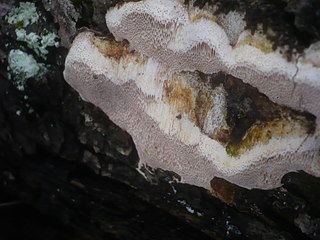
Junghuhnia is a genus of crust fungi in the family Steccherinaceae. It was circumscribed by Czech mycologist August Carl Joseph Corda in 1842. The generic name honours German-Dutch botanist Franz Wilhelm Junghuhn.

Perenniporia is a cosmopolitan genus of bracket-forming or crust-like polypores in the family Polyporaceae. They are dimitic or trimitic with smooth, thick-walled basidiospores and cause a white rot in affected wood.

Phanerochaete is a genus of crust fungi in the family Phanerochaetaceae.

The Meruliaceae are a family of fungi in the order Polyporales. According to a 2008 estimate, the family contains 47 genera and 420 species. As of April 2018, Index Fungorum accepts 645 species in the family.

The Phanerochaetaceae are a family of mostly crust fungi in the order Polyporales.

Postia is a genus of brown rot fungi in the family Fomitopsidaceae.

Byssomerulius is a widely distributed genus of crust fungi.

Phlebia is a genus of mostly crust fungi in the family Meruliaceae. The genus has a widespread distribution. Phlebia species cause white rot.

Gloeoporus is a genus of crust fungi in the family Irpicaceae. The genus has a widespread distribution.
Hjortstamia is a genus of corticioid fungi in the family Phanerochaetaceae. It was circumscribed by French mycologists Jacques Boidin and Gérard Gilles in 2003.

Ceriporia is a widely distributed genus of crust fungi.

Hydnophlebia is a genus of five species of toothed crust fungi in the family Meruliaceae. All species are wood-decay fungi that cause a white rot.

Hyphoderma is a genus of crust fungi in the family Meruliaceae. It was circumscribed by German botanist Karl Friedrich Wilhelm Wallroth in 1833.

Hypochnicium is a genus of corticioid fungi in the family Meruliaceae. The genus was circumscribed by mycologist John Eriksson in 1958.

Steccherinum is a widely distributed genus of toothed crust fungi in the family Steccherinaceae.

Dentocorticium is a genus of six species of poroid fungi in the family Polyporaceae. The genus was revised in 2018, with several new species added and some older species transferred to other genera, based on phylogenetic analyses.

The Irpicaceae are a family of mostly polypores and crust fungi in the order Polyporales.
Efibula is a genus of 16 species of crust fungi in the family Irpicaceae.
Lilaceophlebia is a genus of three species of crust fungi in the family Meruliaceae. The genus was first proposed by Erast Parmasto in 1968 as a section of the genus Phlebia. Viacheslav Spirin and Ivan Zmitrovich elevated the taxon to generic status in 2004.

Botryobasidium is a genus of corticioid fungi belonging to the order Cantharellales. Basidiocarps are ephemeral and typically form thin, web-like, white to cream, effused patches on the underside of fallen branches, logs, and leaf litter. Several species form anamorphs producing chlamydospores. All species are wood- or litter-rotting saprotrophs and the genus has a worldwide distribution.
















